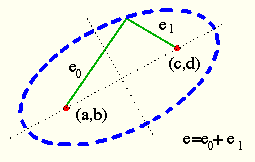
Gegeben: die beiden Fokuspunkte ![]() und
und ![]() sowie die Fokusdistanz
sowie die Fokusdistanz ![]() :
:

und es gilt:

welche ``etwas'' komplex ist, am Besten man verwendet ein
Algebrasystem (z.B. Maple
Waterloo Maple Inc.![[*]](footnote.png) ),
um die explizite Form aus der impliziten Form zu bestimmen:
),
um die explizite Form aus der impliziten Form zu bestimmen:
![\begin{eqnarray*}
y &=& f(x) \\
& & \\
\lefteqn{f(x) = 1/(2\cdot(-4e^2+4d^2+4...
...\right] \\
& & \\
& & \mbox{und}\quad \sqrt{(c-a)^2+(d-b)^2}<e
\end{eqnarray*}](img92.gif)
siehe zweidimensionale Transformationen